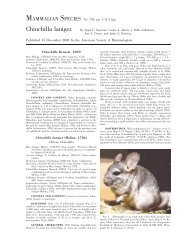Brugia Malayi - Clark Science Center - Smith College
Brugia Malayi - Clark Science Center - Smith College
Brugia Malayi - Clark Science Center - Smith College
Create successful ePaper yourself
Turn your PDF publications into a flip-book with our unique Google optimized e-Paper software.
Isoflurane Impacts the Actin Cytoskeletal Signalling Pathway by Depleting<br />
Cofilin Reserves in Neonatal Murine Cortical Tissue<br />
Belinda Nhundu and Shimu Liu<br />
General anesthetic toxicity is a major concern in obstetric, pediatric and geriatric medicine. In previous experiments carried in<br />
the Hall laboratory, we tested the neurotoxicity of both inhalant and intravenous general anesthetics on murine cortical neurons<br />
in primary dissociated culture. We discovered that the neonatal neurons were remarkably robust, suffering little degeneration at<br />
clinical concentrations and exposure lengths (Campbell et al, 2011). 1<br />
However, when exposed to clinical concentrations of isoflurane and ketamine, extensive neurite retraction was observed. This<br />
result was supported by Turina et al. (2008) 2 who described how neurites of cultured rat cortical neurons retracted after exposure<br />
to the intravenous anesthetic, propofol, resulting in a retraction bulbs and thin trailing neurite remnants.<br />
In an effort to quantify this retraction, we then developed culturing techniques for cortical neurons from postnatal mice<br />
(P0-P2) based on a culturing protocol described by Jana et al. (2007). This protocol largely removes glial cells resulting in a<br />
sparse plating of isolated neurons We also utilized a largely homogeneous neuroblastoma cell line. Neurons were visualized on a<br />
confocal microscope using DIC , and time-lapse imaging was performed to monitor the changes resulting from volatile anesthetic<br />
exposures. General anesthetic solutions of 1, 2, and 5 MAC of sevo- and isoflurane were introduced (1 MAC, minimum alveolar<br />
concentration ~ the clinical concentration for maintaining a plane of anesthesia). Immediately (~5 min) after exposure we<br />
observed a decrease in overall cell motility and changes in cell morphology including thinning and shortening of neurites.<br />
We hypothesized that a Rho-A signaling pathway may be responsible for the anesthetic-induced retraction process leading to<br />
cytoskeletal rearrangement (whereby ↑ Rho-A activity ↑Rock ↑LIM Kinase-1à Phosphorylation of Cofilin). It has been<br />
reported that it may lead to actin polymerization/depolymerization and hence cytoskeletal reorganization.<br />
Using Western blot analysis we measured the levels of phosphorylated and unphosphorylated cofilin in isoflurane-treated<br />
neuroblastoma. Samples of total protein were collected from differentiated neuroblastoma cell lines exposed to 2 MAC<br />
isoflurane for ten minutes and four hours. Western blot results showed a decrease in both phosphorylated and unphosphorylated<br />
cofilin. These results suggest that isoflurane has an impact on cell morphology and dynamics of immature brain cells through<br />
perturbation of molecular events governing cytoskeltela formation. In October we will be presenting our work at the Society for<br />
Neuroscience conference in New Orleans and continue this work as an honors project in the 2012-13 academic year. (Supported<br />
by the National Institutes of Health and the Blakeslee Fund in the Biological <strong>Science</strong>s)<br />
Advisor: Adam Hall<br />
References:<br />
1<br />
L.Campbell, et.al. Assessment of general anaesthetic cytotoxicity in murine cortical neurones in dissociated culture.Toxicology 283(2011), pp.1-7 .<br />
2<br />
D. Turina, V. M. Loitto, K. Björnström, T. Sundqvist, and C. Eintrei.Propofol causes neurite retraction in neurones Br. J. Anaesth. (2008) 101(3): 374-379.<br />
first published online June 27, 2008 doi:10.1093/bja/aen185.<br />
2012<br />
151

















